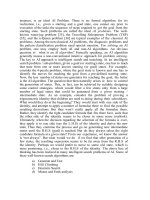Using artificial intelligence
Bạn đang xem bản rút gọn của tài liệu. Xem và tải ngay bản đầy đủ của tài liệu tại đây (95.22 KB, 6 trang )
MIT SL
SLO
OAN MANA
MANAGEMEN
GEMENT
T REVIEW
DIGIT
DIGITAL
AL
Using Artificial Intelligence to Promote Diversity
PAUL R. DAUGHERTY, H. JAMES WILSON, AND RUMMAN CHOWDHURY
AI can help us overcome biases instead of perpetuating them, with guidance from
the humans who design, train, and refine its systems.
That could eventually result in a more diverse and
inclusive world. What if, for instance, intelligent
machines could help organizations recognize all worthy
job candidates by avoiding the usual hidden prejudices
that derail applicants who don’t look or sound like those
in power or who don’t have the “right” institutions listed
on their résumés? What if software programs were able to
account for the inequities that have limited the access of
minorities to mortgages and other loans? In other words,
what if our systems were taught to ignore data about race,
gender, sexual orientation, and other characteristics that
aren’t relevant to the decisions at hand?
Artificial intelligence has had some justifiably bad press
recently. Some of the worst stories have been about
systems that exhibit racial or gender bias in facial
recognition applications or in evaluating people for jobs,
loans, or other considerations. 1 One program was
routinely recommending longer prison sentences for
blacks than for whites on the basis of the flawed use of
recidivism data. 2
But what if instead of perpetuating harmful biases, AI
helped us overcome them and make fairer decisions?
Copyright © Massachusetts Institute of Technology, 2018. All rights reserved.
AI can do all of this — with guidance from the human
experts who create, train, and refine its systems.
Specifically, the people working with the technology must
do a much better job of building inclusion and diversity
into AI design by using the right data to train AI systems
to be inclusive and thinking about gender roles and
diversity when developing bots and other applications
that engage with the public.
Design for Inclusion
Software development remains the province of males —
only about one-quarter of computer scientists in the
United States are women 3 — and minority racial
groups, including blacks and Hispanics, are
Reprint #60216
/>
MIT SL
SLO
OAN MANA
MANAGEMEN
GEMENT
T REVIEW
DIGIT
DIGITAL
AL
underrepresented in tech work, too. 4 Groups like Girls
Who Code and AI4ALL have been founded to help close
those gaps. Girls Who Code has reached almost 90,000
girls from various backgrounds in all 50 states, 5 and
AI4ALL specifically targets girls in minority
communities. Among other activities, AI4ALL sponsors a
summer program with visits to the AI departments of
universities such as Stanford and Carnegie Mellon so that
participants might develop relationships with researchers
who could serve as mentors and role models. And
fortunately, the AI field has a number of prominent
women — including Fei-Fei Li (Stanford), Vivienne Ming
(Singularity University), Rana el Kaliouby (Affectiva),
and Cynthia Breazeal (MIT) — who could fill such a
need.
These relationships don’t just open up development
opportunities for the mentees — they’re also likely to turn
the mentors into diversity and inclusion champions, an
experience that may affect how they approach algorithm
design. Research by sociologists Frank Dobbin of
Harvard University and Alexandra Kalev of Tel Aviv
University supports this idea: They’ve found that working
with mentees from minority groups actually moves the
needle on bias for the managers and professionals doing
the mentoring, in a way that forced training does not. 6
Other organizations have pursued shorter-term solutions
for AI-design teams. LivePerson, a company that develops
online messaging, marketing, and analytics products,
places its customer service staff (a profession that is 65%
female in the United States) alongside its coders (usually
male) during the development process to achieve a better
balance of perspectives. 7 Microsoft has created a
framework for assembling “inclusive” design teams,
which can be more effective for considering the needs
Copyright © Massachusetts Institute of Technology, 2018. All rights reserved.
and sensitivities of myriad types of customers, including
those with physical disabilities. 8 The Diverse Voices
project at the University of Washington has a similar goal
of developing technology on the basis of the input from
multiple stakeholders to better represent the needs of
nonmainstream populations.
Some AI-powered tools are designed to mitigate biases in
hiring. Intelligent text editors like Textio can rewrite job
descriptions to appeal to candidates from groups that
aren’t well-represented. Using Textio, software company
Atlassian was able to increase the percentage of females
among its new recruits from about 10% to 57%. 9
Companies can also use AI technology to help identify
biases in their past hiring decisions. Deep neural
networks — clusters of algorithms that emulate the
human ability to spot patterns in data — can be especially
effective in uncovering evidence of hidden preferences.
Using this technique, an AI-based service such as Mya
can help companies analyze their hiring records and see if
they have favored candidates with, for example, light skin.
Train Systems With
Better Data
Building AI systems that battle bias is not only a matter of
having more diverse and diversity-minded design teams.
It also involves training the programs to behave
inclusively. Many of the data sets used to train AI systems
contain historical artifacts of biases — for example the
word woman is more associated with nurse than with
doctor — and if those associations aren’t identified and
removed, they will be perpetuated and reinforced. 10
While AI programs learn by finding patterns in data, they
need guidance from humans to ensure that the software
Reprint #60216
/>
MIT SL
SLO
OAN MANA
MANAGEMEN
GEMENT
T REVIEW
DIGIT
DIGITAL
AL
doesn’t jump to the wrong conclusions. This provides an
important opportunity for promoting diversity and
inclusion. Microsoft, for example, has set up the Fairness,
Accountability, Transparency, and Ethics in AI team,
which is responsible for uncovering any biases that have
crept into the data used by the company’s AI systems.
Sometimes AI systems need to be refined through more
inclusive representation in images. Take, for instance, the
fact that commercial facial recognition applications
struggle with accuracy when dealing with minorities: The
error rate for identifying dark-skinned women is 35%,
compared with 0.8% for light-skinned men. The problem
stems from relying on freely available data sets (which are
rife with photos of white faces) for training the systems. It
could be corrected by curating a new training data set
with better representation of minorities or by applying
heavier weights to the underrepresented data points. 11
Another approach — proposed by Microsoft researcher
Adam Kalai and his colleagues — is to use different
algorithms to analyze different groups. For example, the
algorithm for determining which female candidates
would be the best salespeople might be different from the
algorithm used for assessing males — sort of a digital
affirmative action tactic. 12 In that scenario, playing a
team sport in college might be a higher predictor of
success for women than for men going after a particular
sales role at a particular company.
Give Bots a Variety of
Voices
Organizations and their AI system developers must also
think about how their applications are engaging with
customers. To compete in diverse consumer markets, a
Copyright © Massachusetts Institute of Technology, 2018. All rights reserved.
company needs products and services that can speak to
people in ways they prefer.
In tech circles, there has been considerable discussion
over why, for instance, the voices that answer calls in help
centers or that are programmed into personal assistants
like Amazon’s Alexa are female. Studies show that both
men and women tend to have a preference for a female
assistant’s voice, which they perceive as warm and
nurturing. This preference can change depending on the
subject matter: Male voices are generally preferred for
information about computers, while female voices are
preferred for information about relationships. 13
But are these female “helpers” perpetuating gender
stereotypes? It doesn’t help matters that many female bots
have subservient, docile voices. That’s something that
Amazon has begun to address in its recent version of
Alexa: The intelligent bot has been reprogrammed to
have little patience for harassment, for instance, and now
sharply answers sexually explicit questions along the lines
of “I’m not going to respond to that” or “I’m not sure
what outcome you expected.” 14
Companies might consider offering different versions of
their bots to appeal to a diverse customer base. Apple’s
Siri is now available in a male or female voice and can
speak with a British, Indian, Irish, or Australian accent. It
can also speak in a variety of languages, including French,
German, Spanish, Russian, and Japanese. Although Siri
typically defaults to a female voice, the default is male for
Arabic, French, Dutch, and British English languages.
Just as important as the way they speak, AI bots must also
be able to understand all types of voices. But right now,
many don’t. 15 To train voice recognition algorithms,
companies have relied on speech corpora, or databases of
Reprint #60216
/>
MIT SL
SLO
OAN MANA
MANAGEMEN
GEMENT
T REVIEW
DIGIT
DIGITAL
AL
audio clips. Marginalized groups in society — lowincome, rural, less educated, and non-native speakers —
tend to be underrepresented in such data sets. Specialized
databases can help correct such deficiencies, but they, too,
have their limitations. The Fisher speech corpus, for
example, includes speech from non-native speakers of
English, but the coverage isn’t uniform. Although Spanish
and Indian accents are included, there are relatively few
British accents. Baidu, the Chinese search-engine
company, is taking a different approach by trying to
improve the algorithms themselves. It is developing a new
“deep speech” algorithm that it says will handle different
accents and dialects.
Copyright © Massachusetts Institute of Technology, 2018. All rights reserved.
Ultimately, we believe that AI will help create a more
diverse and better world if the humans who work with the
technology design, train, and modify those systems
properly. This shift requires a commitment from the
senior executives setting the direction. Business leaders
may claim that diversity and inclusivity are core goals, but
they then need to follow through in the people they hire
and the products their companies develop.
The potential benefits are compelling: access to badly
needed talent and the ability to serve a much wider
variety of consumers effectively.
Reprint #60216
/>
MIT SL
SLO
OAN MANA
MANAGEMEN
GEMENT
T REVIEW
DIGIT
DIGITAL
AL
About the Authors
References
8. “Inclusive Design,” Microsoft.com.
Paul R. Daugherty is Accenture’s
chief technology and innovation
officer. He tweets @pauldaugh. H.
James Wilson is managing director
of IT and business research at
Accenture Research. He tweets
@hjameswilson. Rumman
Chowdhury is a data scientist and
social scientist, and Accenture’s
global lead for responsible AI. She
tweets @ruchowdh.
1. L. Hardesty, “Study Finds Gender and
Skin-Type Bias in Commercial Artificial
Intelligence Systems,” MIT News Office,
Feb. 11, 2018.
9. T. Halloran, “How Atlassian Went From
10% Female Technical Graduates to 57%
in Two Years,” Textio, Dec. 12, 2017.
2. E.T. Israni, “When an Algorithm Helps
Send You to Prison,” The New York Times,
Oct. 26, 2017.
10. C. DeBrusk, “The Risk of MachineLearning Bias (and How to Prevent It),”
MIT Sloan Management Review, March
26, 2018.
3. L. Camera, “Women Can Code — as
Long as No One Knows They’re Women,”
U.S. News & World Report, Feb. 18, 2016.
11. J. Zou and L. Schiebinger, “AI Can Be
Sexist and Racist — It’s Time to Make It
Fair,” Nature, July 12, 2018.
4. M. Muro, A. Berube, and J. Whiton,
“Black and Hispanic Underrepresentation
in Tech: It’s Time to Change the Equation,”
The Brookings Institution, March 28,
2018.
12. D. Bass and E. Huet, “Researchers
Combat Gender and Racial Bias in
Artificial Intelligence,” Bloomberg.com,
Dec. 4, 2017.
5. “About Us,” girlswhocode.com.
6. F. Dobbin and A. Kalev, “Why Diversity
Programs Fail,” Harvard Business Review
94, no. 7/8 (July-August 2016).
7. R. Locascio, “Thousands of Sexist AI
Bots Could Be Coming. Here’s How We
Can Stop Them,” Fortune, May 10, 2018.
Copyright © Massachusetts Institute of Technology, 2018. All rights reserved.
Reprint #60216
13. B. Lovejoy, “Sexism Rules in Voice
Assistant Genders, Show Studies, but Siri
Stands Out,” 9to5Mac.com, Feb. 22, 2017.
14. J. Elliot, “Let’s Stop Talking to Sexist
Bots: The Future of Voice for Brands,” Fast
Company, March 7, 2018.
15. S. Paul, “Voice Is the Next Big
Platform, Unless You Have an Accent,”
Wired, March 20, 2017.
/>
Reproduced with permission of copyright owner. Further reproduction
prohibited without permission.









